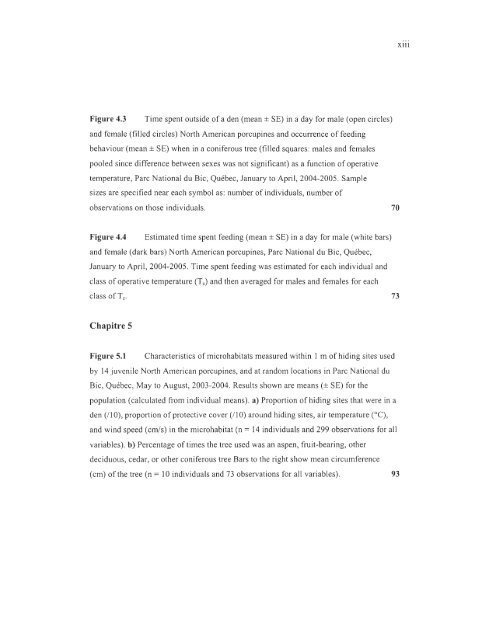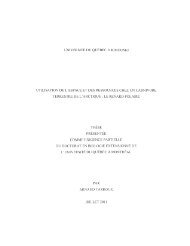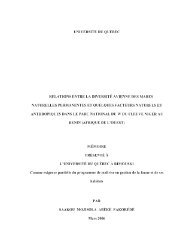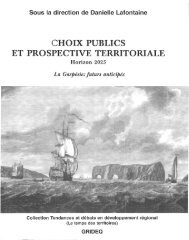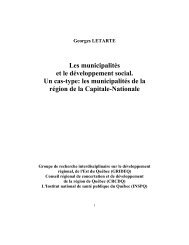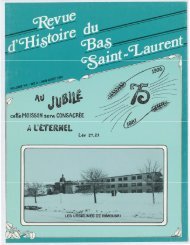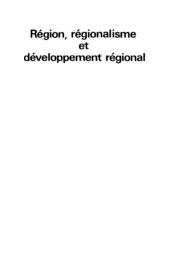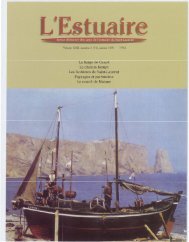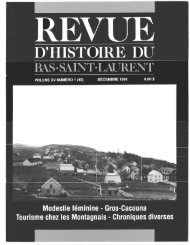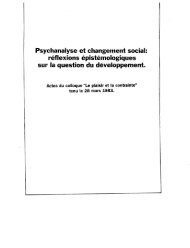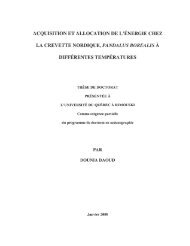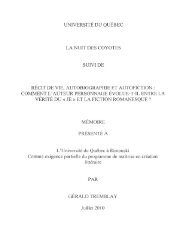influence du climat et de la prédation sur l'utilisation de l'habitat et la ...
influence du climat et de la prédation sur l'utilisation de l'habitat et la ...
influence du climat et de la prédation sur l'utilisation de l'habitat et la ...
Create successful ePaper yourself
Turn your PDF publications into a flip-book with our unique Google optimized e-Paper software.
Xlll<br />
Figure 4.3 Time spent outsi<strong>de</strong> of a <strong>de</strong>n (mean ± SE) in a day for male (open circles)<br />
and female (filled circles) North American porcupines and occurrence of feeding<br />
behaviour (mean ± SE) wh en in a coniferous tree (filled squares: males and females<br />
pooled since difference b<strong>et</strong>ween sexes was not significant) as a function of operative<br />
temperature, Parc National <strong>du</strong> Bic, Québec, January to April, 2004-2005. Sample<br />
sizes are specified near each symbol as: number of indivi<strong>du</strong>als, number of<br />
observations on those indivi<strong>du</strong>als. 70<br />
Figure 4.4 Estimated time spent feeding (mean ± SE) in a day for male (white bars)<br />
and female (dark bars) North American porcupines, Parc National <strong>du</strong> Bic, Québec,<br />
January to April, 2004-2005. Time spent feeding was estimated for each indivi<strong>du</strong>al and<br />
c1ass of operative tempe rature (Te) and then averaged for males and females for each<br />
c<strong>la</strong>ss of Tc.<br />
73<br />
Chapitre 5<br />
Figure 5.1 Characteristics of microhabitats mea<strong>sur</strong>ed within 1 m of hiding sites used<br />
by 14 juvenile North American porcupines, and at random locations in Parc National <strong>du</strong><br />
Bic, Québec, May to August, 2003-2004. Results shown are means (± SE) for the<br />
popu<strong>la</strong>tion (calcu<strong>la</strong>ted from indivi<strong>du</strong>al means). a) Proportion ofhiding sites that were in a<br />
<strong>de</strong>n (/10), proportion of protective co ver (/10) around hiding sites, air temperature (oC),<br />
and wind speed (cm/s) in the microhabitat (n = 14 indivi<strong>du</strong>als and 299 observations for ail<br />
variables). b) Percentage oftimes the tree used was an aspen, fruit-bearing, other<br />
<strong>de</strong>ci<strong>du</strong>ous, cedar, or other coniferous tree Bars to the right show mean circumference<br />
(cm) of the tree (n = 10 indivi<strong>du</strong>als and 73 observations for aU variables). 93


